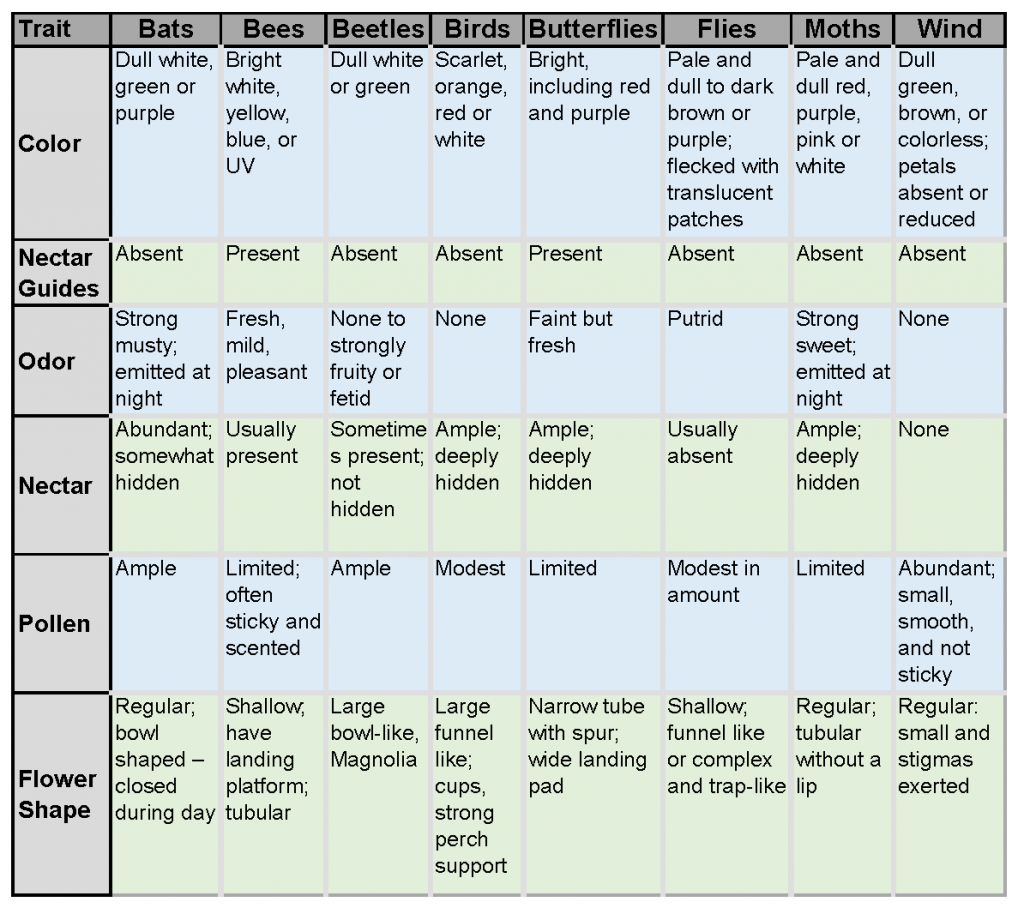From the Hort Desk – Pollinator Syndromes
- 2020-11-08
- By mkirk
- Posted in The Garden Buzz
By Lisa Mason, CSU Extension Horticulture Agent
Now that the days are shorter and the cooler weather is here, this can be a nice time to begin thinking about your garden plans and goals for next season. Are you interested in planting more pollinator-friendly plants? Have you thought about why some plants attract pollinators while other may not?
What is a Pollinator Syndrome?
In general, research has shown that plants have specific flower traits that attract pollinators, and the plants provide the pollinator with nectar and pollen rewards. These attractive traits can include flower color, odor, shape, and availability of pollen and nectar. Some plants even have nectar guides which are markings showing where the pollinator should go to collect the reward. Different traits attract different pollinators. Why would a plant evolve with traits to attract pollinators? Because visiting pollinators will facilitate plant reproduction. This relationship benefits both the plants and the pollinators.
For example, bird pollination is called “ornithophily.” In Colorado, hummingbirds are primary bird pollinators. We know that hummingbirds generally prefer to visit flowers that are red, orange, or white. The flowers tend to be funnel-shaped, hang loosely on the plant, and have plenty of nectar deep in the flowers. For other birds around the world such as sunbirds, honeycreepers and honeyeaters, the plants tend to have strong perch support for the bird to land. Flowers that attract birds typically don’t have an odor, because birds don’t need the scent to find the flowers. You might also notice that the flower petals tend to curve outward to make it easier for a hummingbird in flight to drink nectar.

The USDA Forest Service compiled a chart of pollinator syndromes for the major groups of pollinators.

A wide variety of research is available demonstrating different pollinator syndromes. I want to share two research studies with you.
Darwin’s Prediction of the Long-Spurred Orchid
In the 1860’s, Darwin studied orchids including the long-spurred orchid, Angraecum sesquipedal. He predicted the flowers were pollinated by a long-tongued moth because the flower has a long spur approximately 12-inches long! The nectar sources are located deep in those long spurs. When Darwin received a specimen of this orchid, his wrote, “… good heavens what insect can suck it” (Darwin, 1862b).
At the time, no pollinators had been observed pollinating these orchid flowers. Scientists predicted that the pollinator could possibly be the species, Xanthopan morganii, and subspecies, Xanthopan morganii praedicta, commonly called the Morgan’s sphinx moth because they have a proboscis length (tongue-like tube) that averages over 8 inches long. More than 130 years later after Darwin’s prediction, documentation of this moth pollinating the orchid was finally published beginning in 1993 (Arditti et al., 2012). To learn more, I recommend reading this journal article.
Pollinator Syndromes in Columbines
Another research example that we see in Colorado shows that columbines (Aquilegia spp.) have adapted and evolved to attract different pollinators depending on their spur length. This is considered a “pollinator shift” when the plant adapts to the traits of a pollinator (Whittall and Hodges, 2007).

Your Garden and Pollinator Syndromes
With anything, there are always exceptions to the rules. If you are looking to plant flowers to attract pollinators, you can use pollinator syndromes as a general guideline, but we recommend doing additional research and reading about pollinator-friendly plants that grow well in your area. For instance, to support pollinators, avoid double flowers. Many double-flowered horticultural varieties typically do not have pollen and nectar available for flower visitors.
Here are some resources for pollinator-friendly plant lists:
- Creating Pollinator Habitat: https://extension.colostate.edu/docs/pubs/insect/05616.pdf
- Attracting Native Bees to Your Yard: https://extension.colostate.edu/docs/pubs/insect/05615.pdf
- Attracting Butterflies to the Garden: https://extension.colostate.edu/docs/pubs/insect/05504.pdf
- Low-Water Native Plants for Pollinators: https://conps.org/wp-content/uploads/2015/05/Low-Water-Native-Plants-for-Pollinators-brochure-6-8-15.pdf
References
Arditti, J., Elliott, J., Kitching, I. J., Wasserthall, L. T. ‘Good Heavens what insect can suck it’ – Charles Darwin, Angraecum sesquipedale and Xanthopan morganii praedicta. Botanical Journal of the Linnean Society 169, Issue 3, 403-432 (2012). https://doi.org/10.1111/j.1095-8339.2012.01250.x
Darwin CR 1862b. Letter 3411-Darwin, C. R., to Hooker, J. D, 25 January 1862. Available at: http://www.darwinproject.ac.uk/entry-3411
Whittall, J., Hodges, S. Pollinator shifts drive increasingly long nectar spurs in columbine flowers. Nature 447,706–709 (2007). https://doi.org/10.1038/nature05857
Horticulture Resources
- Garden Buzz Archives
- CSU Extension Resources
- Colorado Master Gardener Program
- Foothills to Plains Native Plant Master Program
- Native Bee Watch Community Science Program
- The Co-Hort Blog
- PlantTalk Colorado
- Soil Testing
- Plant Select
- Emerald Ash Borer
- Japanese Beetle
- Colorado State Forest Service
- Ask an Expert


